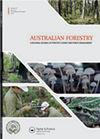Eucalyptus bakeri: a potential source species for eucalyptus oil production in the subtropics
IF 1.2
4区 农林科学
Q3 FORESTRY
引用次数: 2
Abstract
ABSTRACT There is a paucity of eucalypt species in tropical Australia that produce a foliar essential oil in high concentration and rich in 1,8-cineole, the sought-after component of medicinal eucalyptus oils. Eucalyptus bakeri, a mallee from the dry subtropical parts of northern New South Wales and Queensland, is an exception, with limited earlier studies reporting that this species produced foliar oil with commercial characteristics. The aim of this study was to determine the variation in foliar oil characteristics throughout the natural range of E. bakeri as a precursor to the more intensive field-testing of the species as a commercial source of eucalyptus oil. Mature leaves and, when available, coppice leaves for comparison were collected over three separate field trips in 2020 from individual trees representing each of 17 provenances throughout the natural range of E. bakeri in Queensland. Foliar oil concentrations on a fresh-weight basis throughout the provenances sampled were relatively high, averaging 2.3% for mature leaves and 2.8% for coppice leaves, with an individual tree high of 4.1% for both leaf categories. 1,8-Cineole was the dominant compound in all foliar oils sampled, averaging 89.3% (range 70.2–94.6%) in oils from mature leaves and 87.6% (range 79–92.5%) from coppice leaves. Sabinene levels, restricted to a maximum of 0.3% in some oil standards, averaged 0.3% (range trace – 1.5%) in oils from mature leaves and 0.4% (range trace – 0.7%) from coppice leaves. The high foliar oil concentrations and consistency in oil qualities mark this species as a potential candidate as a eucalyptus oil source species for the dry subtropics. Provenance/progeny trials are now needed to determine which provenances produce adequate growth rates and the silviculture required to manage the species as an oil-producing crop, as well as to investigate variations in oil characteristics, including sabinene levels, when all sources are grown at a common site.巴克里桉树:亚热带桉树油生产的潜在来源物种
摘要:在澳大利亚热带地区,生产高浓度、富含1,8-桉叶素(药用桉树油中备受追捧的成分)的桉树品种很少。巴克里桉树是一种来自新南威尔士州北部和昆士兰干燥亚热带地区的木槌,是一种例外,早期有限的研究报告称,该物种生产出具有商业特征的叶油。本研究的目的是确定E.bakeri整个自然范围内叶油特性的变化,作为对该物种作为桉树油商业来源进行更深入实地测试的前兆。2020年,在昆士兰E.bakeri自然范围内,通过三次单独的实地考察,从代表17个种源的每一棵树上采集了成熟的叶子和矮林叶子进行比较。在整个取样种源中,以鲜重为基础的叶油浓度相对较高,成熟叶平均为2.3%,矮树叶平均为2.8%,两种叶类的单株高达4.1%。1,8-Cineole是所有取样叶油中的主要化合物,成熟叶油的平均含量为89.3%(范围70.2~94.6%),矮叶油的含量为87.6%(范围79~92.5%)。在一些油标准中,Sabinene的含量最高限制为0.3%,成熟叶的油中Sabinene含量平均为0.3%(微量-1.5%),矮树叶的Sabinene水平平均为0.4%(微量-0.7%)。高叶油浓度和油质一致性标志着该物种是干旱亚热带桉树油源物种的潜在候选物种。现在需要进行种源/后代试验,以确定哪些种源能产生足够的生长率,以及将该物种作为产油作物进行管理所需的造林,并调查当所有来源都生长在一个共同的地点时,石油特征的变化,包括马齿苋水平。
本文章由计算机程序翻译,如有差异,请以英文原文为准。
求助全文
约1分钟内获得全文
求助全文
来源期刊

Australian Forestry
FORESTRY-
CiteScore
3.70
自引率
4.80%
发文量
15
审稿时长
>12 weeks
期刊介绍:
Australian Forestry is published by Taylor & Francis for the Institute of Foresters of Australia (IFA) for scientific, technical, and professional communication relating to forestry in the Asia Pacific.
 求助内容:
求助内容: 应助结果提醒方式:
应助结果提醒方式:


